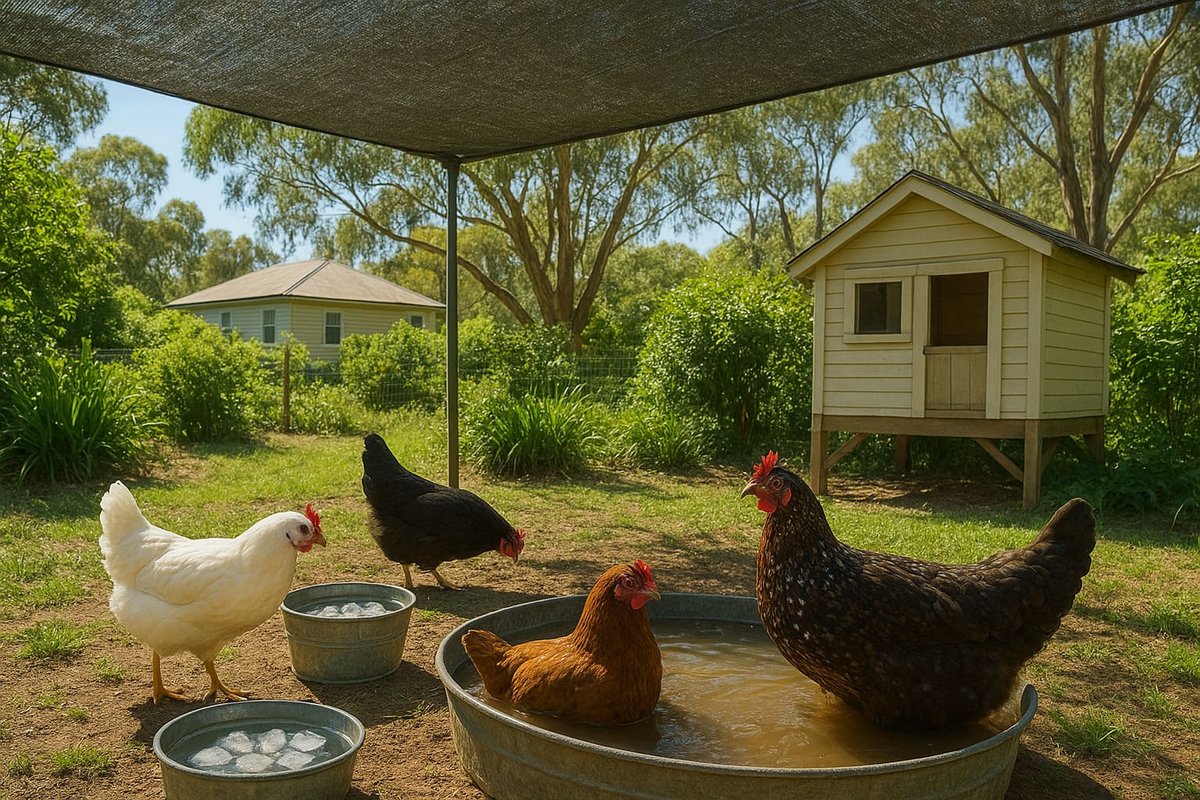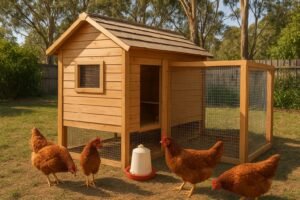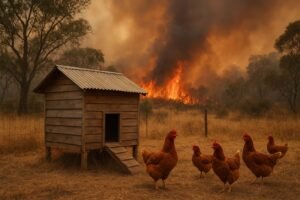Keeping backyard chickens in Australia is a fantastic experience, but our sizzling summers can be incredibly tough on chooks. When the temperature soars, some breeds struggle, leading to stress, a drop in egg production in hot climates, and serious health risks.
Choosing the right breed from the start is the single best way to make sure your flock stays healthy, happy, and productive when the heatwaves roll in. This guide will walk you through the 10 heat-tolerant chicken breeds perfect for the Australian climate, helping you find the right fit for your backyard. We’ll look at breeds big and small, the best layers, and some true Aussie classics. These birds are naturally better at handling the heat, which means less stress for them and for you.
Let’s dive into the top breeds that won’t just survive an Aussie summer, but can actually thrive in one.
Best Heat-Tolerant Chicken Breeds for Australia: Small, Medium, and Large Options

Here are our top picks for chickens that can take the heat. We’ve added pros, cons, and a noise level to give you the full picture.
1. Leghorn: The Classic Heat-Tolerant Layer
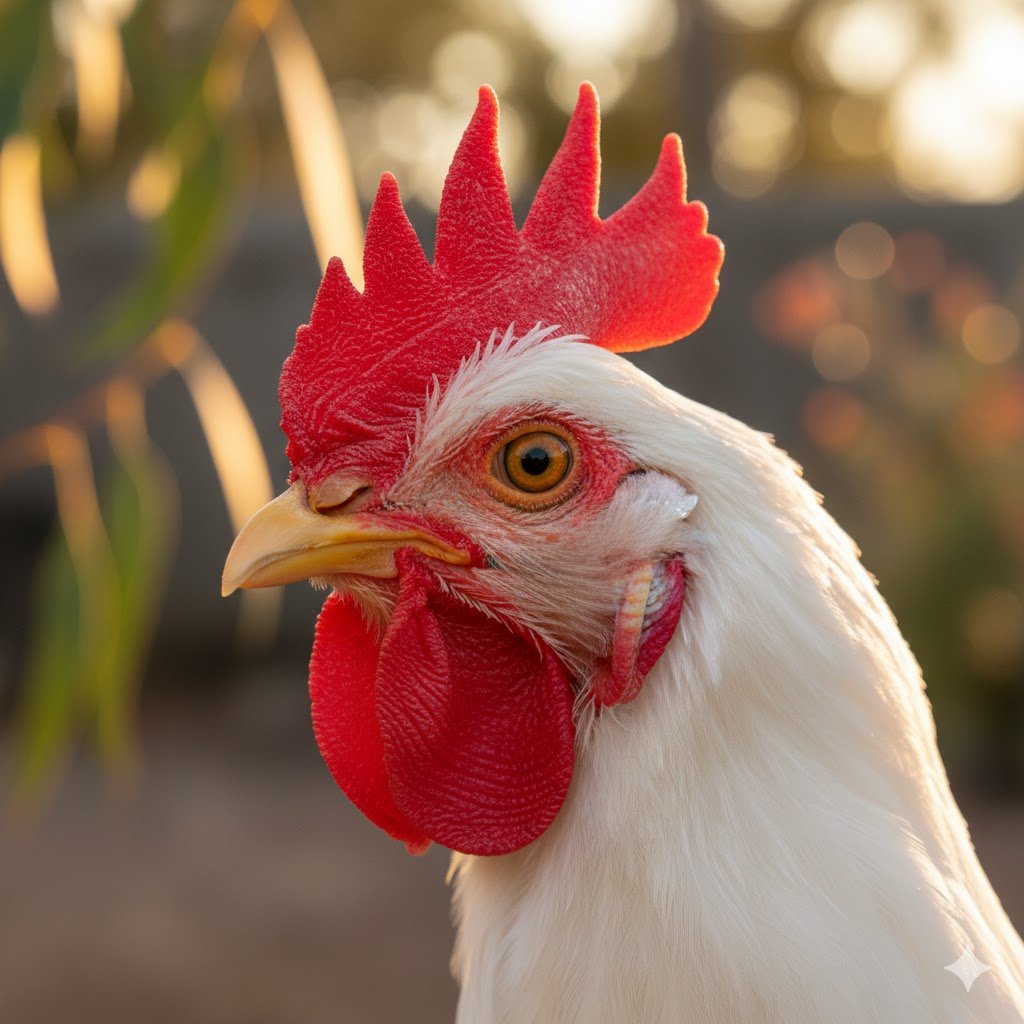
Leghorns (pronounced “Legg-orn”) are famous for being some of the best egg laying chickens for hot climates.
- Why they handle heat: They come from Italy (a warm climate!) and have a light, slim body. Their most important feature is a large single comb and wattles, which act like a radiator. Blood flows to the comb, cools down in the air, and then circulates back into the body.
- Egg Production: Excellent. You can expect 280-320 large white eggs per year.
- Temperament: Active, chatty, and great foragers. They can be flighty and nervous, so they may not be the best “cuddle” chicken for kids.
- Noise Level: High. They are very talkative and known for their loud “egg song” after laying.
- Pros: Top-tier egg layer, excellent heat tolerance, great forager (finds lots of their own food).
- Cons: Noisy, flighty (can fly over low fences), and not a cuddly pet.
2. Australorp: The Aussie Favourite
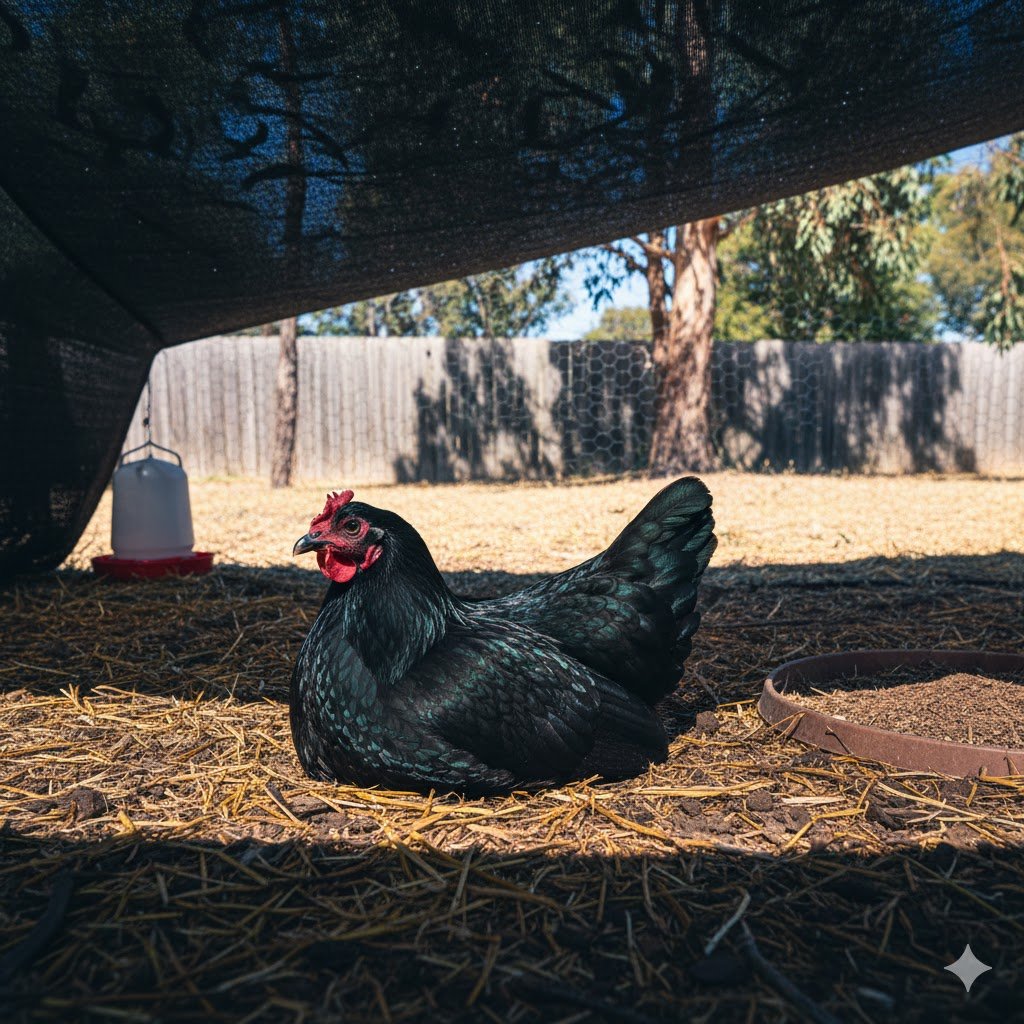
The Australorp is an Australian-bred chicken, developed from the British Orpington to be a more practical, hardy bird for our conditions.
- Why they handle heat: As an Aussie breed, they are generally very adaptable. They are larger birds but are less fluffy than their Orpington ancestors, which helps.
- Egg Production: Very good. They are famous layers, producing around 250-300 light brown eggs per year.
- Temperament: Calm, gentle, and friendly. They make wonderful family pets and are one of the most popular backyard chickens Australia has to offer.
- Noise Level: Low to moderate. They are generally very quiet and placid.
- Pros: Fantastic “all-rounder,” friendly and great with kids, excellent layer, and Aussie-bred.
- Cons: Their black feathers absorb heat, so providing deep, constant shade is not optional for this breed.
3. Rhode Island Red: The Hardy All-Rounder
Rhode Island Reds (or “RIRs”) are one of the most successful chicken breeds in the world, and for good reason.
- Why they handle heat: They are incredibly hardy and adaptable. While they are a large heat tolerant chicken breed, their single comb helps them cool off. They were bred to handle both cold New England winters and hot summers.
- Egg Production: Excellent. A solid 200-300 large brown eggs per year.
- Temperament: Confident, curious, and sometimes a bit bossy with other chickens. Roosters can be known for being protective (aggressive).
- Noise Level: Moderate. They’re not as quiet as an Australorp but not as noisy as a Leghorn.
- Pros: Super hardy, reliable egg layer, great forager, good dual-purpose (eggs and meat) bird.
- Cons: Can be bossy to more timid breeds, and roosters are often too aggressive for a backyard setup.
4. Fayoumi: The Ultimate Heat Survivor
If you live in a very hot, dry part of Australia, the Fayoumi is a breed to look at.
- Why they handle heat: They come from Egypt and have been bred for thousands of years to survive in the desert. They have light bodies, large combs, and are not as heavily feathered. They are also known to need less water than other breeds.
- Egg Production: Good. Around 150-200 smallish, off-white eggs per year.
- Temperament: Very active, flighty, and almost “wild.” They are amazing foragers but do not like being handled.
- Noise Level: High. They are very alert and vocal, making a lot of noise if they spot anything new.
- Pros: The most heat-tolerant breed you can get, excellent forager, very predator-savvy.
- Cons: Not a pet, very flighty, can be noisy, and lays smaller eggs.
5. New Hampshire Red: The Fast-Growing Cousin
A close relative of the Rhode Island Red, the New Hampshire Red was bred to grow faster and produce meat as well as eggs.
- Why they handle heat: Like the RIR, they are a tough and adaptable American breed. They cope well with a range of temperatures, including Aussie heat, as long as they have shade and water.
- Egg Production: Good, with around 150-180 large brown eggs per year.
- Temperament: Generally calmer and less aggressive than RIRs. They are known to be quite friendly and food-motivated.
- Noise Level: Moderate. Generally a calm and quiet breed.
- Pros: Very friendly, great dual-purpose bird, good layer, calmer than a Rhode Island Red.
- Cons: Can be prone to going “broody” (wanting to sit on eggs) in summer, which can be dangerous for them in the heat.
6. Ancona: The Spotted Italian
Another fantastic breed from the Mediterranean, the Ancona is like a “spotty Leghorn.”
- Why they handle heat: They share all the same heat-beating traits as the Leghorn: light body, large comb, and active nature. Their “mottled” spots are also thought to help with camouflage.
- Egg Production: Excellent, laying up to 280 large white eggs per year.
- Temperament: Busy, flighty, and alert. They are great at avoiding predators but don’t enjoy being cooped up.
- Noise Level: High. Very similar to the Leghorn, they are a chatty breed.
- Pros: Excellent layer, handles heat extremely well, beautiful appearance.
- Cons: Very flighty (needs a tall fence or covered run), noisy, not a pet.
7. ISA Brown: The Backyard Classic
The ISA Brown isn’t a “breed” in the traditional sense, but a modern hybrid (sex-link) designed for commercial egg laying. They are the most common backyard layer in Australia.
- Why they handle heat: They were bred to be adaptable and productive in a wide range of conditions. They are a medium-sized bird and cope reasonably well with heat, though they will need care during an extreme heatwave.
- Egg Production: Exceptional. Bred to lay, you can expect 300+ brown eggs in their first 1-2 years.
- Temperament: Very docile, friendly, and trusting. They are a perfect beginner’s chicken and fantastic with kids.
- Noise Level: Low. They are typically very quiet and gentle.
- Pros: Super friendly, amazing egg layer, great for beginners and children.
- Cons: Shorter productive lifespan (egg-laying often drops off hard after 2 years), more prone to reproductive health issues.
8. Sussex: The Gentle Giant
The Sussex is an old English breed that is loved for its calm nature and pretty looks (the “Light Sussex” is the most popular).
- Why they handle heat: They are adaptable and hardy. While they are a large heat tolerant chicken breed, the lighter-coloured varieties (like Light and Speckled) reflect the sun and cope better than dark-coloured birds.
- Egg Production: Good, with around 200-250 light brown or tinted eggs per year.
- Temperament: Calm, curious, and very gentle. They are a wonderful, easy-to-handle chicken for families.
- Noise Level: Low. A very quiet and content breed.
- Pros: Extremely gentle and great with kids, beautiful, good reliable layer.
- Cons: Can get bullied by more aggressive breeds, can get broody.
9. Hamburg: The Spangled Forager
If you want a small heat tolerant chicken breed (technically a bantam in Australia), the Hamburg is a fantastic choice.
Best Small Heat-Tolerant Breed for Australian Backyards
Hamburgs are an outstanding choice if you’re looking for a small heat tolerant chicken breed. They take up less space, eat less feed, and are still great foragers. While they lay smaller eggs, they are a productive and efficient addition to a smaller, free-range setup.
- Why they handle heat: They are a small, active, and sleek-feathered bird. They carry very little “bulk” and are built for running around, which helps them stay cool.
- Egg Production: Good for their size, laying about 200 small white eggs per year.
- Temperament: Very active and flighty. Like Leghorns, they are not a lap chicken. They are born to free-range.
- Noise Level: Moderate to high. They are alert and vocal.
- Pros: Great for free-ranging, small (eats less food), good layer for its size, heat tolerant.
- Cons: Flighty (needs a covered run), small eggs, not a “pet” breed.
10. Plymouth Rock: The Barred Beauty
The Plymouth Rock, or “Barred Rock,” is another classic American breed loved for its hardiness and steady nature.
Best Large Breed for Families (with Cooling Support)
The Plymouth Rock is a classic, friendly breed, making it a family favourite. However, it’s important to note they are a mixed-climate breed and not truly heat-adapted. They can handle warm weather but will require more intervention and cooling support during Aussie heatwaves than breeds like Leghorns. They are not recommended for the hottest, most arid parts of Australia.
- Why they handle heat: They are a mixed-climate breed that can tolerate warm weather with proper management, but require more intervention during heatwaves than true heat-adapted breeds like Leghorns or Fayoumis.
- Egg Production: Very good, at around 200-280 large brown eggs per year.
- Temperament: Calm, friendly, and good foragers. They are a great, dependable backyard chicken.
- Noise Level: Moderate. Generally a calm and easy-going bird.
- Pros: Very reliable, friendly, good layer, handles most conditions well.
- Cons: Not truly heat-adapted and will require significant cooling support on 40°C+ days. Not recommended for the hottest parts of Australia.
Comparison of Heat-Tolerant Chicken Breeds
| Breed | Size Category | Heat Tolerance | Egg Production | Best For |
|---|---|---|---|---|
| Leghorn | Medium | Excellent | High (280-320) | Top Egg Layers |
| Australorp | Large | Very Good | High (250-300) | Families / All-Rounder |
| Rhode Island Red | Large | Very Good | High (200-300) | Hardy All-Rounder |
| Fayoumi | Small | Excellent | Good (150-200) | Hottest Climates / Foraging |
| New Hampshire | Large | Very Good | Good (150-180) | Friendly Dual-Purpose |
| Ancona | Small/Medium | Excellent | High (280) | Free-Range Layers |
| ISA Brown | Medium | Good | Exceptional (300+) | Beginners / Kids |
| Sussex | Large | Good | Good (200-250) | Families / Gentle Pet |
| Hamburg | Small | Very Good | Good (200) | Small Backyards / Foraging |
| Plymouth Rock | Large | Fair (Needs support) | Very Good (200-280) | Families (in milder climates) |
Best Egg-Laying Chickens for Hot Australian Climates
When the heat is on, many breeds stop laying. However, some are superstars that keep producing. If your main goal is a steady supply of eggs through the summer, these are your best choices:
- Leghorn: The undisputed champion. They were bred for high-volume egg laying in a warm Mediterranean climate. Expect 280-320 eggs per year.
- ISA Brown: These hybrids are egg-laying machines. While they might slow down on a 40°C day, they are generally the most reliable layers, giving 300+ eggs in their first year.
- Ancona: Very similar to the Leghorn, this active, heat-tolerant breed will reliably produce around 280 eggs per year.
- Australorp: The best all-rounder, the Australorp is a fantastic layer (250-300 eggs) that also has a calm, friendly temperament.
Choosing Between Small and Large Heat-Tolerant Chicken Breeds in Australia
The size of your breed makes a big difference in an Australian backyard.
Pros and Cons of Small Breeds (e.g., Hamburg, Fayoumi, Ancona)
- Pros:
- Eat Less: They consume less feed, saving you money.
- Less Space: They are a great choice for small heat tolerant chicken breeds in suburban backyards.
- Superior Heat Tolerance: Their smaller body mass makes it easier for them to cool down.
- Cons:
- Smaller Eggs: Their eggs are noticeably smaller than those from larger breeds.
- Flighty: They are often nervous, flighty, and don’t enjoy being handled.
- Noisy: Many small, active breeds (like Leghorns) are quite vocal.
Pros and Cons of Large Breeds (e.g., Australorp, Sussex, Plymouth Rock)
- Pros:
- Friendly: Breeds like the Australorp and Sussex are known for being calm, gentle, and great with kids.
- Larger Eggs: They lay standard large-sized eggs.
- Dual-Purpose: Many large heat tolerant chicken breeds can also be used for meat.
- Cons:
- Eat More: They require significantly more feed.
- Need More Space: They need a larger coop and run to be happy.
- Less Heat Tolerant: While the breeds on our list are good, they will struggle more than a small breed like a Fayoumi in an extreme heatwave.
Choosing a good breed is the perfect start, but even the toughest chook needs a well-managed home. Let’s look at how you can turn your backyard into a cool oasis for your flock.
The Ultimate Guide: How to Keep Chickens Cool in Summer in Australia
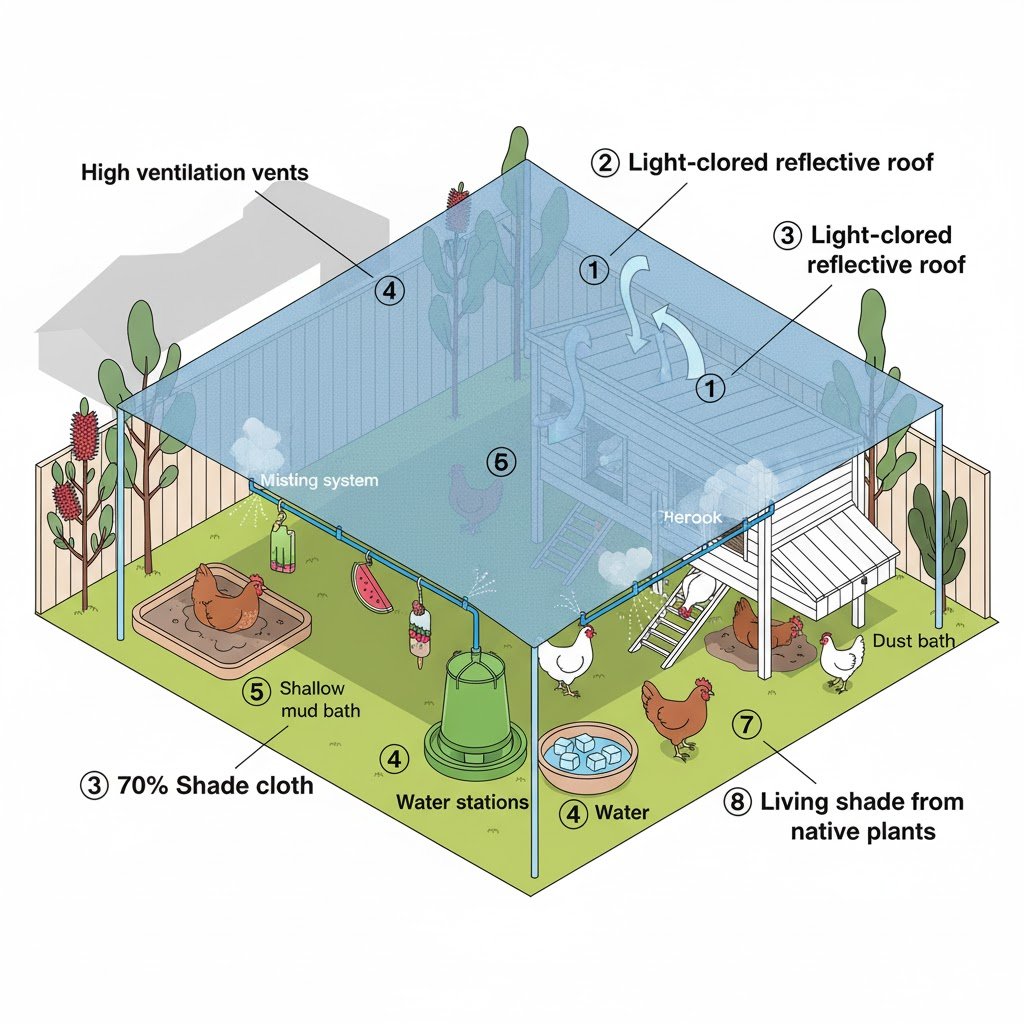
Choosing a heat-tolerant breed is step one. Step two is active management. Even the hardiest chook needs help in a 40°C heatwave. Here are the most effective chicken coop cooling tips.
1. Smart Coop Design for Hot Climates
- Ventilation is Key: Hot air rises. Your coop must have vents up high (near the roof) to let hot air escape. Wide, predator-proof mesh windows (using 10mm x 10mm wire) will allow for a cross-breeze.
- Insulation: An insulated roof is a game-changer. It stops the sun from baking the inside of the coop.
- Colour: A light-coloured or white roof will reflect sunlight and dramatically reduce the temperature inside.
- Positioning: If possible, place your coop in the permanent, deep shade of a large tree or on the south side of your house.
- Biosecurity and Cleanliness: A clean coop prevents disease. Ensure your design stops wild birds (which can carry diseases like Avian Influenza) from mixing with your flock or accessing their feed and water, as recommended by Agriculture Australia. This also includes predator proofing; it’s a good time to snake-proof your coop as snakes are more active in warm weather. You might also want to look at specific snake-proof coop designs for inspiration.

2. Water, Water, and More Water
- Multiple waterers: Have at least two waterers, in different shady spots, in case one gets knocked over or dirty. Keeping water clean is vital for backyard chicken food safety and biosecurity.
- Add Ice: On hot days, drop a big block of ice (from an old ice cream container) into the waterer.
- Electrolytes: On extreme-heat days, add poultry electrolytes (from a pet or stockfeed store) to the water to help the chickens recover from heat stress.
- Incentives: Drop a few berries or a bit of mint into the water to encourage them to drink.
3. Shade is Non-Negotiable
- 70%+ Shade: Chickens must be able to get out of the direct sun. Use 70-90% grade shade cloth (from a hardware store) to cover their run. This is also vital to prevent sunburn (and yes, can chickens get sunburned? They absolutely can, especially light-coloured breeds).
- Living Shade: Plant native, bushy shrubs or a fast-growing vine (like a choko) over their run. This creates “living shade” which is much cooler.
- Dust Baths: Chickens cool themselves by digging in cool earth. Make sure they have a shaded, dry patch of dirt to dig and dust bathe in. This is a key welfare need, as outlined in the Australian Animal Welfare Standards and Guidelines for Poultry, which require chickens to have access to appropriate substrate for pecking and foraging.
4. Cooling Foods and Treats
- “Chook Popsicles”: Freeze corn, peas, berries, and a bit of seed in an ice cream container with water. Hang it up and let them peck at it.
- Water-Rich Foods: A cold wedge of watermelon, cucumber slices, or lettuce are perfect treats for a hot afternoon.
- Avoid: Don’t feed high-energy “scratch” mixes (like corn or wheat) during the hottest part of the day. Digestion creates body heat. Feed them in the cooler evening. For more ideas on what to feed chickens during a heatwave, focus on hydrating, low-energy foods.
5. “Chicken Air-Con” Tricks
- The Mud Bath: Create a muddy patch in a cool, shady corner. The chickens will stand in it and the mud will cool their feet and legs, lowering their whole body temperature.
- Frozen Bottles: Freeze 2L soft drink bottles full of water. Place them in the coop or shady spots in the run for the chickens to lie against.
- Misters: A very fine misting system (from a hardware store) set up in a shady part of the run can provide a lot of relief, but use it sparingly in humid areas.
Knowing how to cool them is vital, but you also need to know when to act. Spotting the signs of heat stress early can save a life.
Heat Stress in Chickens: Signs and Emergency First Aid
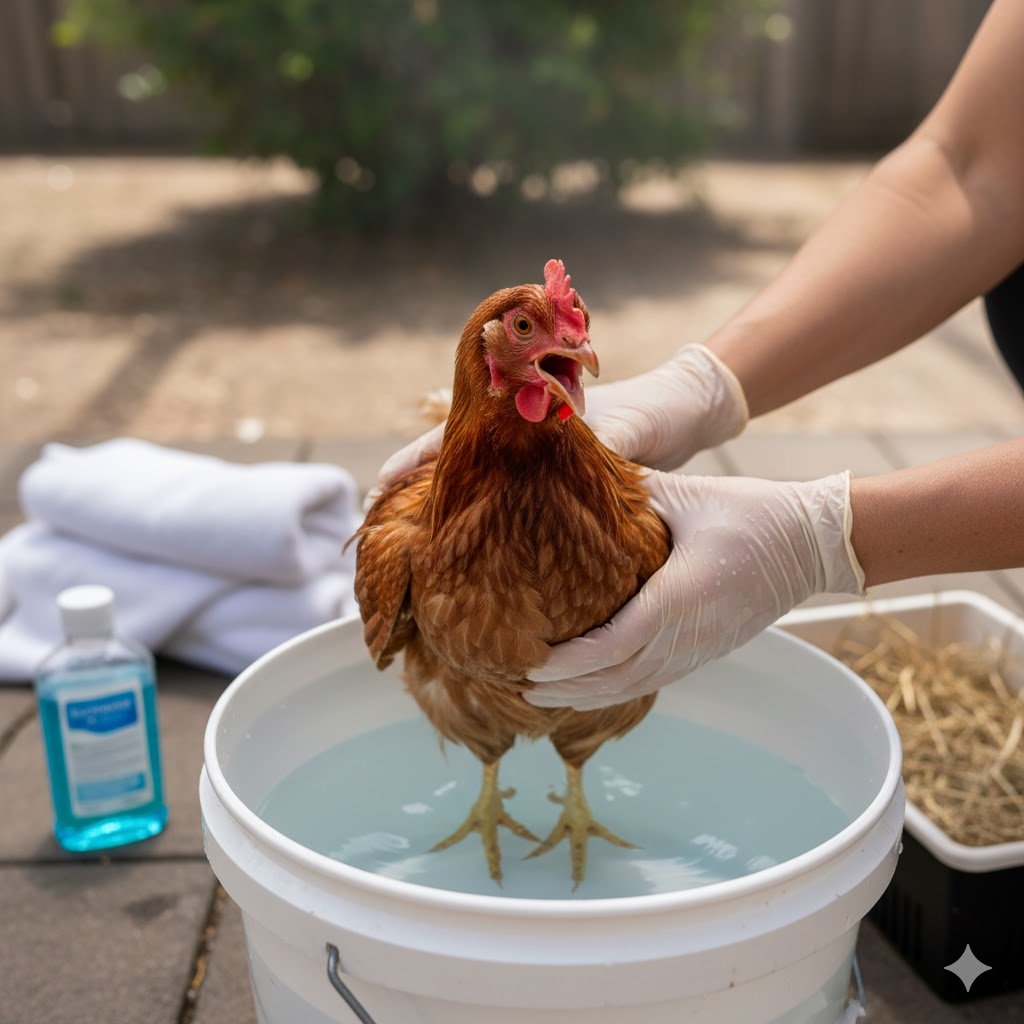
Chickens can go from stressed to critical very quickly. Chickens under heat stress are also more likely to get sick. Keeping your flock healthy year-round with good biosecurity is key. This includes doing a regular chicken health check. You can learn more about poultry health and disease prevention from Agriculture Victoria.
Know the warning signs so you can act fast.
Signs of Heat Stress
- Panting: Breathing with an open beak.
- Wings Out: Holding their wings out from their body to try and release heat.
- Pale Comb: Their comb and wattles look pale or purplish.
- Lethargy: Lying down, looking floppy, and not moving.
- Diarrhoea: Watery poos.
- Seizures: In the final, critical stages.
What to Do Immediately (Actionable First Aid)
- Move Them: Immediately bring the chicken to a cool, dark, quiet place (like a laundry or shaded shed with a fan).
- Offer Water: Give them cool (not ice-cold) water. You can add electrolytes. Do not force them to drink, just have it available.
- Emergency Dunk: This is the best way to save a collapsed bird. Fill a bucket with cool (not icy) water. Gently submerge the chicken’s body, keeping its head and neck well above water at all times. Hold them there for 1-2 minutes. This brings their core temperature down fast.
- Dry and Rest: Gently towel dry the bird and let it recover in the cool, quiet place before returning it to the flock. This is much easier if you set up a first aid kit in advance.
We’ve covered the ‘what to get’ and ‘how to care for them,’ but it’s just as important to know what not to get. Let’s cover the breeds that really struggle in our climate.
Breeds to Avoid for Hot Australian Climates
These breeds are known as “cold-hardy,” meaning they were bred for snow, not sun. They are typically very large, have dense and fluffy feathers, and small combs/wattles, which means they can’t cool themselves down.
- Orpingtons: (The heritage breed, not the Australorp). They are stunning, fluffy balls of feathers and are known to struggle badly, even in mild heat.
- Wyandottes: Another beautiful, fluffy breed with very dense feathers and a small “rose” comb that doesn’t release heat well.
- Brahmas and Cochins: These are giant, feathery breeds (some even have feathers on their feet!). They are beautiful but suffer terribly in the heat and are not recommended for most of Australia.
- Silkies: This popular bantam breed has unique fluffy feathers that can trap heat, and their dark skin may absorb sun. While some keepers report success with Silkies in warm climates, their dense feathering means they require extra care, deep shade, and close monitoring during heatwaves. They may not be the best choice for extreme heat.
Now that you know what to get and what to avoid, let’s answer some of the most common questions our readers ask.
Frequently Asked Questions (FAQ) on Heat-Tolerant Chicken Breeds
Q: What chickens are heat tolerant in Australia?
A: The best heat-tolerant breeds for Australia are Mediterranean breeds like Leghorns and Anconas, desert breeds like the Fayoumi, and adaptable all-rounders like Australorps, Rhode Island Reds, and New Hampshire Reds.
Q: What breed of chicken is most heat tolerant?
A: The Fayoumi is often considered one of the most heat-tolerant breeds in the world, as it was developed in Egypt. For a more common and friendly breed, the Leghorn is a top choice for its amazing ability to cool itself down.
Q: How to keep chickens cool in summer in Australia?
A: The three most important things are: 1) Constant cool, fresh water (in the shade). 2) Plenty of deep shade for all your chickens. 3) A well-ventilated coop that lets hot air escape.
Q: Are chickens ok in 100 degree weather?
A: 100°F (or 38°C) is extremely dangerous for most chickens. They can survive if given plenty of shade, lots of cool water, and cooling treats, but they will be very stressed. Heavier, fluffy breeds are at high risk of heatstroke and death.
Q: Do Orpingtons do well in heat?
A: No. Orpingtons are large, very fluffy birds that were bred for cold English weather. They are known to struggle badly in the heat and are not a good choice for hot Australian climates.
Q: Are Australorps heat tolerant?
A: Yes, Australorps are generally heat tolerant and adaptable. They were bred in Australia, so they are much better suited than breeds like the Orpington. However, their black feathers absorb sun, so it is vital they have access to deep shade on hot days.
Q: Are Wyandotte chickens heat tolerant?
A: Wyandottes are not a good choice for hot climates. Like Orpingtons, they are a large, heavy breed with dense, fluffy feathers. They are known as a “cold-hardy” breed and can overheat very easily in an Aussie summer.
Q: What are the best egg laying chickens for hot climates?
A: The Leghorn is the clear winner here. They are fantastic layers and their light bodies and large combs make them perfectly built for the heat. Anconas are also excellent layers that tolerate heat well.
Q: Does the colour of a chicken matter for heat?
A: Yes! Just like wearing a black t-shirt on a sunny day, black or dark-coloured feathers (like on a Black Australorp) absorb more heat. Lighter-coloured birds (like a Leghorn or Light Sussex) will reflect sunlight and stay slightly cooler.
Q: Do I need council permission for backyard chickens in Australia?
A: Yes, almost certainly. Most local councils have rules about keeping chickens, such as how many you can have, if you can keep a rooster (usually not in suburbs), and how far the coop must be from your fence. Always check your local council’s website first. Better Health Victoria has a good overview of these rules.
Q: How much space do chickens need?
A: This is a common question! Generally, you want at least 0.5 sq metres per chicken inside the coop and 1-2 sq metres per chicken in the outside run. We’ve got a detailed guide on how much space do chickens really need.
Q: How many chickens should I get?
A: Chickens are social, so you need at least three. The right number depends on your egg needs and space. We’ve got a guide on how many chickens do you need for a family of 4 to help you plan.
Q: What are the easiest breeds for beginners?
A: From this list, the Australorp, ISA Brown, and Sussex are fantastic, friendly, and calm, making them some of the easiest breeds for beginners.
Q: Will my chickens stop laying eggs in the heat?
A: Yes, this is very common. High-heat is a major stressor, and a chicken’s body will shut down non-essential functions like egg production in hot climates to conserve energy. You might see fewer eggs, smaller eggs, or eggs with thin shells. This is normal, and they will usually start laying again when it cools down.
Conclusion
Choosing one of these 10 heat-tolerant chicken breeds is the best first step. It helps you avoid one of the common mistakes first-time chicken keepers make (which is choosing the wrong breed for your climate!). Breeds like the Leghorn, Australorp, or Rhode Island Red combine heat hardiness with great egg laying, making them perfect for most backyards.
Remember that even the toughest chook needs your help when the mercury climbs. By combining the right breed with smart management—like a well-ventilated coop, plenty of shade, and lots of cool, fresh water—you’ll have happy chickens all year round. For more on your responsibilities as a keeper, check the RSPCA’s guide on caring for backyard chickens.
About the Author
Jane Smith is a backyard poultry keeper with over 15 years of experience raising healthy, happy chooks in sunny Queensland. She’s a firm believer in sustainable backyard farming and loves sharing practical tips that work for real Aussie backyards.

Oladepo Babatunde is the founder of ChickenStarter.com. He is a backyard chicken keeper and educator who specializes in helping beginners raise healthy flocks, particularly in warm climates. His expertise comes from years of hands-on experience building coops, treating common chicken ailments, and solving flock management issues. His own happy hens are a testament to his methods, laying 25-30 eggs weekly.
